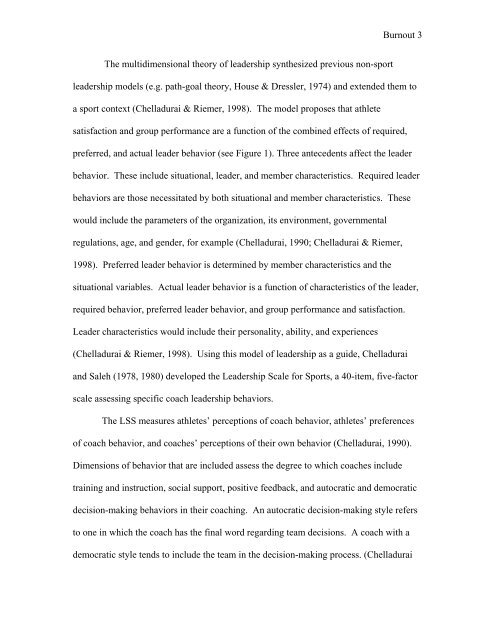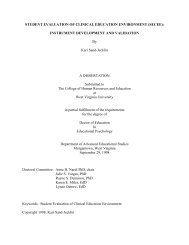Coach and Athlete Burnout - West Virginia University
Coach and Athlete Burnout - West Virginia University
Coach and Athlete Burnout - West Virginia University
You also want an ePaper? Increase the reach of your titles
YUMPU automatically turns print PDFs into web optimized ePapers that Google loves.
The multidimensional theory of leadership synthesized previous non-sport<br />
<strong>Burnout</strong> 3<br />
leadership models (e.g. path-goal theory, House & Dressler, 1974) <strong>and</strong> extended them to<br />
a sport context (Chelladurai & Riemer, 1998). The model proposes that athlete<br />
satisfaction <strong>and</strong> group performance are a function of the combined effects of required,<br />
preferred, <strong>and</strong> actual leader behavior (see Figure 1). Three antecedents affect the leader<br />
behavior. These include situational, leader, <strong>and</strong> member characteristics. Required leader<br />
behaviors are those necessitated by both situational <strong>and</strong> member characteristics. These<br />
would include the parameters of the organization, its environment, governmental<br />
regulations, age, <strong>and</strong> gender, for example (Chelladurai, 1990; Chelladurai & Riemer,<br />
1998). Preferred leader behavior is determined by member characteristics <strong>and</strong> the<br />
situational variables. Actual leader behavior is a function of characteristics of the leader,<br />
required behavior, preferred leader behavior, <strong>and</strong> group performance <strong>and</strong> satisfaction.<br />
Leader characteristics would include their personality, ability, <strong>and</strong> experiences<br />
(Chelladurai & Riemer, 1998). Using this model of leadership as a guide, Chelladurai<br />
<strong>and</strong> Saleh (1978, 1980) developed the Leadership Scale for Sports, a 40-item, five-factor<br />
scale assessing specific coach leadership behaviors.<br />
The LSS measures athletes’ perceptions of coach behavior, athletes’ preferences<br />
of coach behavior, <strong>and</strong> coaches’ perceptions of their own behavior (Chelladurai, 1990).<br />
Dimensions of behavior that are included assess the degree to which coaches include<br />
training <strong>and</strong> instruction, social support, positive feedback, <strong>and</strong> autocratic <strong>and</strong> democratic<br />
decision-making behaviors in their coaching. An autocratic decision-making style refers<br />
to one in which the coach has the final word regarding team decisions. A coach with a<br />
democratic style tends to include the team in the decision-making process. (Chelladurai












